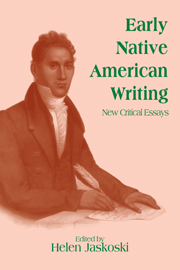Book contents
- Frontmatter
- Contents
- Foreword
- Preface
- List of Contributors
- 1 “Honoratissimi benefactores” Native American students and two seventeenth-century texts in the university tradition
- 2 “Pray Sir, consider a little”: Rituals of subordination and strategies of resistance in the letters of Hezekiah Calvin and David Fowler to Eleazar Wheelock
- 3 “(I speak like a fool but I am constrained)”: Samson Occom's Short Narrative and economies of the racial self
- 4 “Where, then, shall we place the hero of the wilderness?”: William Apess's Eulogy on King Philip and doctrines of racial destiny
- 5 “They ought to enjoy the home of their fathers”: The treaty of 1838, Seneca intellectuals, and literary genesis
- 6 “I am Joaquin!”: Space and freedom in Yellow Bird's The Life and Adventures of Joaquin Murieta, the Celebrated California Bandit
- 7 “This voluminous unwritten book of ours”: Early Native American writers and the oral tradition
- 8 “A terrible sickness among them”: Smallpox and stories of the frontier
- 9 “A desirable citizen, a practical business man”: G. W. Grayson – Creek mixed blood, nationalist, and autobiographer
- 10 “An Indian … An American”: Ethnicity, assimilation, and balance in Charles Eastman's From the Deep Woods to Civilization
- 11 “Overcoming all obstacles”: The assimilation debate in Native American women's journalism of the Dawes era
- 12 “My people … my kind”: Mourning Dove's Cogewea, The Half-Blood as a narrative of mixed descent
- 13 “Because I understand the storytelling art”: The evolution of D'Arcy McNickle's The Surrounded
7 - “This voluminous unwritten book of ours”: Early Native American writers and the oral tradition
Published online by Cambridge University Press: 20 February 2010
- Frontmatter
- Contents
- Foreword
- Preface
- List of Contributors
- 1 “Honoratissimi benefactores” Native American students and two seventeenth-century texts in the university tradition
- 2 “Pray Sir, consider a little”: Rituals of subordination and strategies of resistance in the letters of Hezekiah Calvin and David Fowler to Eleazar Wheelock
- 3 “(I speak like a fool but I am constrained)”: Samson Occom's Short Narrative and economies of the racial self
- 4 “Where, then, shall we place the hero of the wilderness?”: William Apess's Eulogy on King Philip and doctrines of racial destiny
- 5 “They ought to enjoy the home of their fathers”: The treaty of 1838, Seneca intellectuals, and literary genesis
- 6 “I am Joaquin!”: Space and freedom in Yellow Bird's The Life and Adventures of Joaquin Murieta, the Celebrated California Bandit
- 7 “This voluminous unwritten book of ours”: Early Native American writers and the oral tradition
- 8 “A terrible sickness among them”: Smallpox and stories of the frontier
- 9 “A desirable citizen, a practical business man”: G. W. Grayson – Creek mixed blood, nationalist, and autobiographer
- 10 “An Indian … An American”: Ethnicity, assimilation, and balance in Charles Eastman's From the Deep Woods to Civilization
- 11 “Overcoming all obstacles”: The assimilation debate in Native American women's journalism of the Dawes era
- 12 “My people … my kind”: Mourning Dove's Cogewea, The Half-Blood as a narrative of mixed descent
- 13 “Because I understand the storytelling art”: The evolution of D'Arcy McNickle's The Surrounded
Summary
Leslie Marmon Silko's dedication of Storyteller to “the storytellers as far back as memory goes and to the telling which continues and through which they all live and we with them” signals her sense that her written verbal art derives from and builds on a long-standing tradition of spoken verbal art in her community, Laguna Pueblo. This facet of Silko's work has received attention from commentators who note how she both incorporates traditional themes and motifs from Laguna oral tradition into her fiction (Ruoff, “Ritual”) and views her work as a link in the chain of transmission that extends from the past and into the future (Lucero; Ruppert; Wong 186–96). Silko's connectedness with oral tradition parallels that of many authors who have shaped the “Native American Renaissance” of the late twentieth century (Lincoln). Scholars have often noted that the American Indian writers whose work has generated that renaissance represent the continuation of tribal traditions of verbal art and participate in expressive cultures rooted in the spiritual and intellectual contexts of their own local communities.
Not as much attention, though, has been paid to the ways in which writing by Native Americans in the nineteenth and early twentieth centuries relates to the oral tradition. In fact, many students of this writing, especially of the autobiographical works, have instead emphasized its parallels with Euroamerican literature. Arnold Krupat, for example, views the self-definition emerging from William Apess's A Son of the Forest as “deriving entirely from Christian culture” (145).
- Type
- Chapter
- Information
- Early Native American WritingNew Critical Essays, pp. 122 - 135Publisher: Cambridge University PressPrint publication year: 1996

